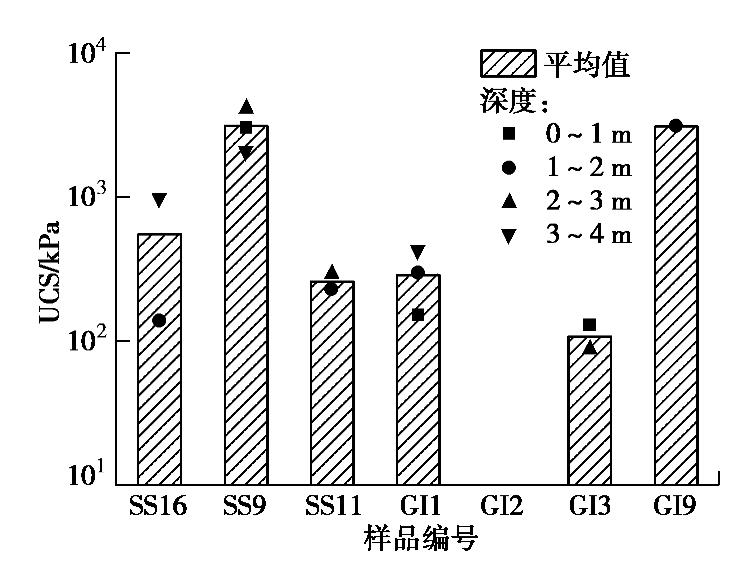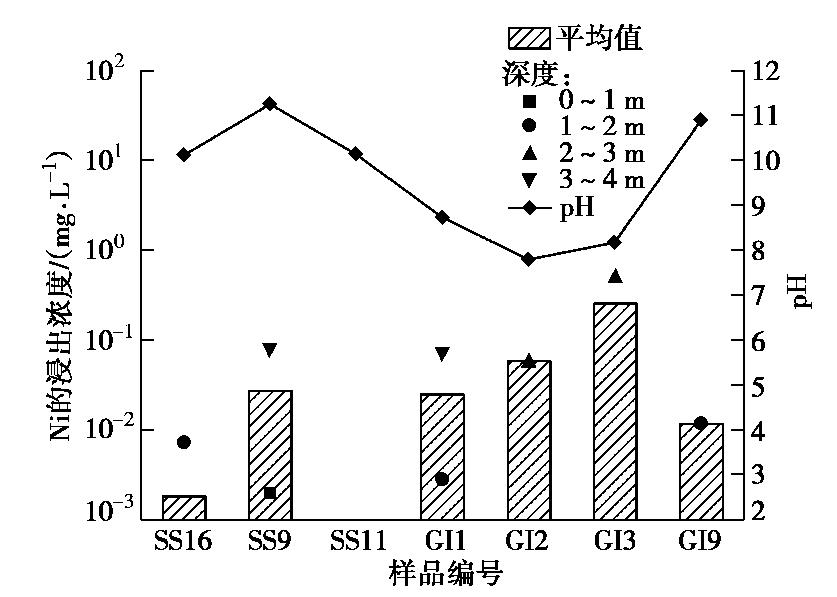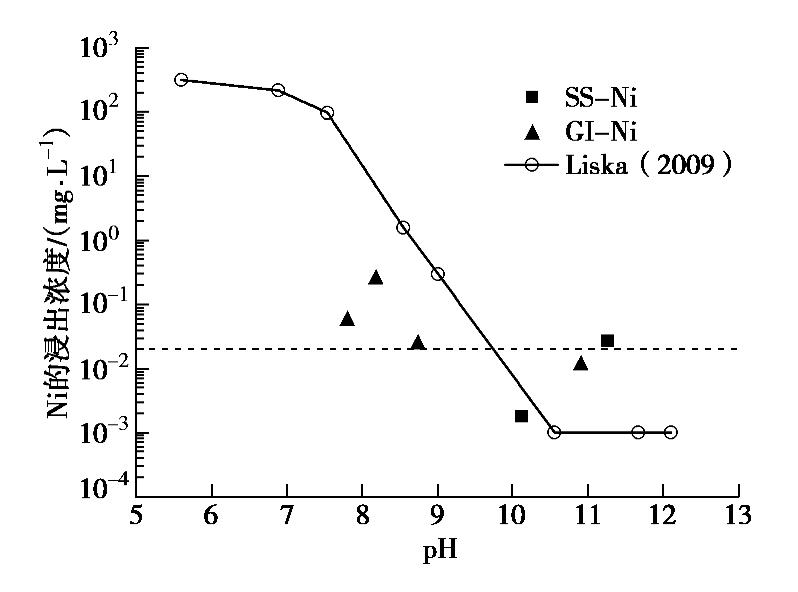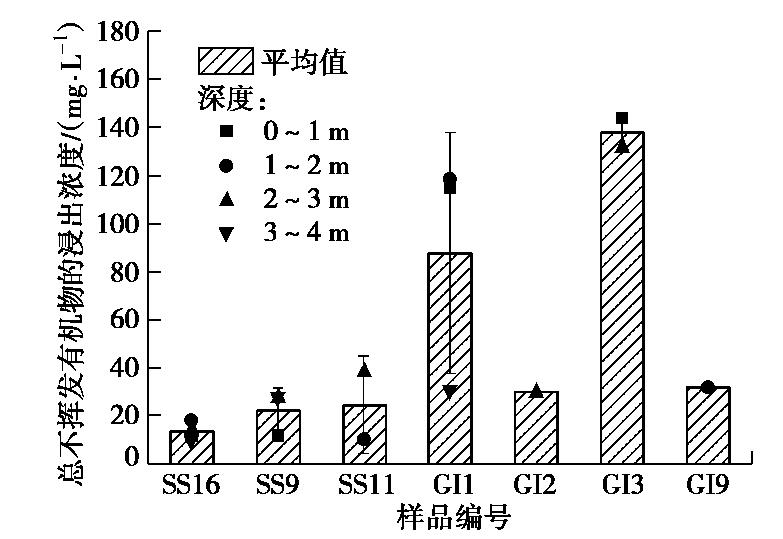Strength and leaching performances of stabilized/solidified (S/S) and ground improved (GI) contaminated site soils
-
摘要: 研究了固化/稳定化和软土加固两种土壤搅拌技术修复英国Yorkshire郡的重金属及有机物复合污染土的强度和浸出特性。使用的固化剂为氧化镁和高炉矿渣。选取现场固化/稳定化和软土加固处理后取回实验室分别养护1.5 a和1 a的试样,开展了无侧限抗压强度和浸出试验,研究了场地深度对两种技术处理复合污染土的强度和浸出特性的影响。研究结果表明,氧化镁-高炉矿渣可以显著提升污染土强度,固化土无侧限抗压强度均值均超过英国的设计值350 kPa;浸出结果表明修复后除部分样中Ni不达标,Cu和Pb的浸出浓度均达到英国饮用水标准。氧化镁和高炉矿渣联合使用可以有效固化Ni。相较于软土加固技术,固化/稳定化技术修复污染土pH值更高、Ni浸出浓度和有机物浸出浓度更低,在固化重金属和有机物复合污染土方面效果更加显著。场地深度对修复后污染土的性质影响微弱。Abstract: The soil mixing technologies (SMT) such as stabilization/solidification (S/S) and ground improvement (GI) are used to treat heavy metal and organic-contaminated site soils in the Castleford, Yorkshire site, UK. The ground granulated blastfurnace slag (GGBS) and magnesia (MgO) are used in this study. The unconfined compressive strength (UCS) tests as well as the BS EN12457 batch leaching tests are conducted on the S/S contaminated soils at 1.5 years and GI soils at 1 year to assess the influences of different depths on the strength and leaching performances of these samples. The results show that the MgO-GGBS can significantly improve the strength of contaminated soils as the average UCS of MgO-GGBS-treated samples exceeds 350 kPa suggested by the UK design standard. Moreover, except part of Ni, the leaching concentrations of Cu and Pb are able to meet drinking water standard of the England. The combination of MgO and GGBS are found to be able to immobilize Ni efficiently. Compared with the GI technique, the S/S technique can achieve higher pH, lower leaching concentration of both Ni and organic compounds, which is more effective in immobilizing heavy metals and organic compounds. The depth of the site has few influences on the properties of contaminated soils after remediation.
-
0. 引言
各向异性是黏土的基本性质之一,分为原生各向异性和次生各向异性。针对原生各向异性对黏土力学性状的影响,许多学者对与沉积平面呈不同夹角试样进行压缩、无侧限压缩和三轴压缩等试验,发现原生各向异性对黏土变形以及强度特性的影响不容忽视。
小应变剪切模量特性作为土的重要力学性质之一,也同样受到原生各向异性的影响。Simpson等[1]的研究表明,小应变剪切模量的原生各向异性对隧道及基坑周围土体变形的预测结果影响很大;Jovičić等[2]和吴宏伟等[3]分别针对伦敦黏土和上海软黏土进行研究,利用弯曲元测得两种土在低围压下水平和竖直方向上的最大剪切模量比值分别为1.5和1.21,说明对于不同种类黏土,原生各向异性对其小应变剪切模量的影响不尽相同。
结构性黏土在我国东南沿海地区分布广泛,许多工程建设涉及到此类黏土,迄今已对其小应变剪切模量进行了诸多研究,但以往的研究主要考虑孔隙比、应力水平和结构损伤等对小应变剪切模量的影响[4],而考虑原生各向异性对小应变剪切模量影响的研究较少,有必要进行系统探究。
本文对不同削样方向的湛江黏土原状试样开展不同围压下的共振柱试验,研究原生各向异性对最大动剪切模量的影响以及考虑原生各向异性的最大动剪切模量随围压演化规律的表征方法。
1. 试验材料与试验方案
1.1 试验材料与试样制备
土样取自湛江市某基坑内地下10~11 m,尺寸为30 cm×30 cm×30 cm原状块状样。表1为其基本物理力学指标与颗粒组成。由表1可见,湛江黏土具有较差物理性质,与软黏土相似,但力学性质较优,呈现上述特性的原因为其具有的强结构性[4]。
表 1 湛江黏土平均物理力学性质指标与颗粒组成Table 1. Physical and mechanical indexes and particle composition of Zhanjiang clay重度γ/(kN·m-3) 含水率w/% 孔隙比e 渗透系数K/(cm·s-1) 液限wL/% 塑限wP/% 塑性指数IP 结构屈服应力σk/kPa 无侧限抗压强度/kPa 灵敏度St 颗粒组成/% >0.05/mm 0.005~0.05/mm 0.002~0.005/mm <0.002/mm 17.1 52.98 1.44 2.73×10−8 59.6 28.1 31.5 400 143.5 7.2 8.2 39.5 20.7 31.6 图1(a)为不同方向圆柱试样示意图,定义试样轴线与土体沉积平面夹角为
α ,即竖直方向试样为90°,水平方向试样为0°。针对α 为0°,22.5°,45°,67.5°,90°方向原状样进行研究,试样规格尺寸为直径50 mm,高度100 mm的圆柱体。1.2 试验方法
试验所用设备为GDS共振柱仪,如图1(b)所示。试样的边界条件为一端固定,一端自由。通过电磁驱动系统对试样逐级施加扭矩,测得试样的共振频率和对应的剪应变,试样动剪切模量由下式得到:
G=ρ(2πfH/β)2, (1) 式中,G为试样动剪切模量,ρ为试样密度,f为共振频率,H为试样高度,β为扭转振动频率方程特征值。
试样在抽气饱和后安装至共振柱仪上,随后进行反压饱和,当B值达0.98后,进行固结,围压分别设定为50,100,200,300,400,500,600,700,800 kPa。试样固结完成后,进行共振柱试验。
2. 试验结果与分析
2.1 不同方向试样G-
γ 曲线规律如图2所示,不同方向试样动剪切模量G和剪应变
γ 的关系曲线形态与规律类似。剪切模量在小剪应变下衰减速度较小;随剪应变发展,衰减速度增大。低围压下G-γ 曲线随围压增大而上移,围压超过600~700 kPa,G-γ 曲线随围压增长而下移,与通常软黏土G-γ 曲线大多随围压增大而单调上移规律存在明显差异,说明结构性对湛江黏土G-γ 曲线规律影响较大。2.2 原生各向异性对最大动剪切模量的影响
湛江黏土动应力-应变关系可用Hardin-Drnevich双曲线模型表征,如下式:
τ=γa+bγ, (2) 式中,a,b为拟合参数。式(2)可以写为
1/G=a+bγ。 (3) 式(3)中,当
γ 趋近于0时,得到最大动剪切模量Gmax=1/a,利用式(3)求得不同方向试样在各围压下的Gmax。为了消除孔隙比对Gmax的影响,引入孔隙比函数F(e)=1/(0.3+0.7e2)将Gmax进行归一化处理,图3为经孔隙比函数归一化的Gmax/F(e)-围压σ3 曲线。随围压增大,不同方向试样Gmax/F(e)-σ3 曲线均呈现先上升后下降的规律,在围压为400~500 kPa即在σk 左右时,曲线出现转折。为了更好描述原生各向异性对最大动剪切模量的影响,定义Gmax/F(e)的原生各向异性系数:
Kα=Dα/D90°, (4) 式中,Dα定义为α方向试样的Gmax/F(e),D90°定义为90°(竖直)方向试样的Gmax/F(e)。
Gmax/F(e)的原生各向异性系数Kα与围压的关系如图4所示。相同围压下,Kα随方向角
α 变化,Kα整体上随α 增大而减小,即试样的方向越靠近水平其刚度越大,说明原生各向异性对湛江黏土最大动剪切模量Gmax的影响十分显著。湛江黏土基本单元为扁平状片堆、粒状碎屑矿物与单片颗粒,上述基本单元在沉积时,其长轴更倾向于水平方向,导致颗粒间水平方向的接触更紧密,结构更强[3],进而更靠近水平方向试样的刚度更大。当围压低于400~600 kPa时,同一方向试样Kα随围压增长基本保持恒定,K0°,K22.5°,K45°,K67.5°,K90°分别为1.314,1.279,1.148,1.045,1;当围压高于400~600 kPa时,同一方向试样Kα随围压增长呈明显减小趋势,不同方向试样的Gmax/F(e)差异减小。说明围压低于
σk 时,围压的增大几乎不影响原生各向异性对Gmax的影响,但当围压超过σk 后,围压的增大减弱了原生各向异性对Gmax的影响。文献[2]中伦敦黏土在围压超过屈服应力后,其水平与竖直方向试样的最大剪切模量的差异随围压增长也呈减小趋势,与本文试验结果一致。2.3 考虑原生各向异性的最大动剪切模量表征方法
图3中出现Gmax/F(e)随围压增大呈先上升后下降的特殊现象,文献[4]认为Gmax同时受到平均有效应力、孔隙比和结构损伤的影响,采用该文的表征方法对试验结果进行分析,具体的表达形式如下所示:
Gmax/F(e)=A(1+(σ′mpa)n)1+B(1+(σ′mpa)n)(kr+1−kr1+(ησ′mpc)λ)。 (5) 式中 A,B,n,kr,η和
λ 为反映各种应力历史和土体性质的参数;σ′m 为围压;pa为标准大气压;pc为表观前期固结压力即结构屈服应力σk ,不同方向试样压缩试验得到的σk 差异较小,均取400 kPa。采用式(5)将不同方向试样Gmax/F(e)与围压的关系进行定量表征。从图4可得,高应力下各向异性对试样的Gmax/F(e)影响减弱,可假定不同方向试样Gmax/F(e)极限值相同。最终将试验数据与拟合曲线一同绘制于图5,发现拟合效果很好,拟合参数见表2。
表 2 不同方向试样拟合参数Table 2. Fitting parameters of specimens in different directionsα A/MPa B n kr η λ R2 0° 39.92489 0.16678 0.54309 0.35092 0.56433 6.42998 0.99251 22.5° 37.89951 0.15999 0.58264 0.35462 0.56426 6.37147 0.99075 45° 33.76328 0.15168 0.54642 0.37740 0.55402 6.38473 0.99432 67.5° 31.15476 0.15761 0.56254 0.42499 0.60889 6.07737 0.99727 90° 29.75422 0.15743 0.56067 0.44448 0.57750 6.05669 0.99835 分析表2中拟合参数与试样方向的关系,可得参数A,kr,
λ 和试样轴线与土体沉积平面夹角α 呈线性关系(图6),参数B,n,η随α 增大分别保持在0.1587,0.5591,0.5738上下,且波动范围较小(参数B,n,η的标准差S分别为0.005455,0.01570和0.02131)。将图6中参数A,kr,
λ 的拟合方程和参数B,n,η的平均值同时代入式(5),得到考虑原生各向异性的最大动剪切模量的表征方法:Gmax/F(e)=(c1α+c2)(1+(σ′mpa)n)1+B(1+(σ′mpa)n)· ((d1α+d2)+1−(d1α+d2)1+(ησ′mpc)(e1α+e2))。 (6) 式中
σ′m 为围压;α 表示试样的方向,为试样轴线与土体沉积平面夹角;pa为标准大气压,取101.325 kPa;pc为σk ,取400 kPa;B=0.1587,n=0.5591,η=0.5738;c1=−0.1204,c2=39.9166;d1=1.144×10−3,d2=0.3390;e1=−4.625×10−3,e2=6.4722。3. 结论
(1)在同一围压下,不同
α 试样经孔隙比函数归一化的最大动剪切模量Gmax/F(e)与90°方向试样Gmax/F(e)的比值Kα随α 增大而减小。当围压低于和高于σk 时,同一α 试样Kα随围压增长分别呈基本保持恒定与明显减小趋势,说明当围压低于σk 时,围压几乎不影响原生各向异性对Gmax影响,围压超过σk 后,不同方向的Gmax/F(e)差异减小,围压的增大减弱了原生各向异性对Gmax的影响。(2)受固结压硬和结构损伤的影响,湛江黏土的Gmax/F(e)变化规律与通常软黏土试验结果不同,不同方向试样的Gmax/F(e)随围压增大均呈先增大后减小规律,当围压在
σk 左右时出现转折。(3)基于采用考虑结构损伤的公式可很好拟合湛江黏土不同方向试样Gmax与围压关系曲线,提出了考虑原生各向异性影响的Gmax演化规律表征方法。
-
表 1 土壤污染物及其含量[2]
Table 1 Concentrations of soil contaminants
污染物 浓度范围/(mg·kg-1) Pb 95~175 Zn 150~220 As 130~140 Cu 1075~1600 Ni 1170~2200 Cr 700~1150 总有机物 7185~9230 表 2 固化剂化学成分(%)[31]
Table 2 Compositions of binder materials
主要成分 氧化镁 高炉矿渣 SiO2 0.9 36.5 CaO 1.9 39.5 Al2O3 0.1 12.5 Fe2O3 0.8 0.5 MgO 93.5 8.5 K2O — 0.4 Na2O — 0.2 TiO2 — 0.5 LOI 2.78 — 表 3 固化剂组合成分
Table 3 Compositions of binders
样品编号 土/% 水/% 固化剂 MgO/% GGBS/% MgO∶GGBS SS16 70.0 15.0 1.50 13.50 1∶9 SS9 85.0 7.5 0.75 6.75 1∶9 SS11 85.0 7.5 7.50 0 — GI1 90.0 0 10.00 0 — GI2 95.0 0 5.00 0 — GI3 97.5 0 2.50 0 — GI9 97.5 0 2.25 0.25 9∶1 -
[1] AL-TABBAA A, BARKER P, EVANS C W. Soil mix technology for land remediation: recent innovations[C]//Proceedings of the Institution of Civil Engineers Ground Improvement, 2011, Great Britain: 127-137.
[2] AL-TABBAA A, LISKA M, OUELLET-PLAMONDON C, et al. Soil mix technology for integrated remediation and ground improvement: from laboratory work to field trials[C]//Proceedings of the Fourth International Conference on Grouting and Deep Mixing, 2012, New Orleans: 522-532.
[3] GU K, JIN F, AL-TABBAA A, et al. Incorporation of reactive magnesia and quicklime in sustainable binders for soil stabilisation[J]. Engineering Geology, 2015, 195: 53-62. doi: 10.1016/j.enggeo.2015.05.025
[4] WU H L, JIN F, BO Y L, et al. Leaching and microstructural properties of lead contaminated kaolin stabilized by GGBS-MgO in semi-dynamic leaching tests[J]. Construction and Building Materials, 2018, 172: 626-634. doi: 10.1016/j.conbuildmat.2018.03.164
[5] YI Y, LISKA M, AL-TABBAA A. Initial investigation into the use of GGBS-MgO in soil stabilisation[C]//Proceedings of the Fourth International Conference on Grouting and Deep Mixing, 2012, New Orleans: 444-453.
[6] 薄煜琳. 粒化高炉矿渣和氧化镁固化稳定化铅污染黏土的强度、溶出及微观特性的研究[D]. 南京: 东南大学, 2015. Bo Yu-Lin. The Strength, Leaching and Microscopic Mechanism of Ground Granulated Blast Furnace Slag and Magnesium Oxide Stabilized Lead-contaminated Soils[D]. Nanjing: Southeast University, 2015, (in Chinese)
[7] NIDZAM R M, KINUTHIA J M. Sustainable soil stabilisation with blastfurnace slag - a review[J]. Construction Materials: Proceedings of the Institution of Civil Engineers, 2010, 163(3): 157-165. doi: 10.1680/coma.2010.163.3.157
[8] SHI C, DAY R L. Chemical activation of blended cements made with lime and natural pozzolans[J]. Cement and Concrete Research, 1993, 23(6): 1389-1396. doi: 10.1016/0008-8846(93)90076-L
[9] SHI C, FERNáNDEZ-JIMéNEZ A. Stabilization/solidification of hazardous and radioactive wastes with alkali-activated cements[J]. Journal of Hazardous Materials, 2006, 137(3): 1656-1663. doi: 10.1016/j.jhazmat.2006.05.008
[10] 陈恩义, 李体祯. 优质粒化高炉矿渣粉的生态环保功效[J]. 混凝土世界, 2011(5): 26-30. doi: 10.3969/j.issn.1674-7011.2011.05.006 CHEN En-yi, LI Ti-zhen. The ecological environmental effect of high quality blast furnace slag power[J]. China Concrete, 2011(5): 24-28. (in Chinese) doi: 10.3969/j.issn.1674-7011.2011.05.006
[11] DU Y J, BO Y L, JIN F, et al. Durability of reactive magnesia-activated slag-stabilized low plasticity clay subjected to drying-wetting cycle[J]. European Journal of Environmental and Civil Engineering, 2016, 20: 215-230. doi: 10.1080/19648189.2015.1030088
[12] LISKA M. Properties and Applications of Reactive Magnesia Cements in Porous Blocks[D]. Cambridge: University of Cambridge, 2010.
[13] SHAND M A. The Chemistry and Technology of Magnesia[M]. Hoboken, New Jersey: John Wiley & Sons, Inc., 2006.
[14] JIN F, GU K, AL-TABBAA A. Strength and hydration properties of reactive MgO-activated ground granulated blastfurnace slag paste[J]. Cement and Concrete Composites, 2015, 57: 8-16. doi: 10.1016/j.cemconcomp.2014.10.007
[15] JIN F, AL-TABBAA A. Evaluation of novel reactive MgO activated slag binder for the immobilisation of lead and zinc[J]. Chemosphere, 2014, 117: 285-294. doi: 10.1016/j.chemosphere.2014.07.027
[16] YI Y, LISKA M, AL-TABBAA A. Properties and microstructure of GGBS-magnesia pastes[J]. Advances in Cement Research, 2014, 26(2): 114-122. doi: 10.1680/adcr.13.00005
[17] SHEN Z, PAN S, HOU D, et al. Temporal effect of MgO reactivity on the stabilization of lead contaminated soil[J]. Environment International, 2019, 131.
[18] JIN F, WANG F, AL-TABBAA A. Three-year performance of in-situ solidified/stabilised soil using novel MgO-bearing binders[J]. Chemosphere, 2016, 144: 681-688. doi: 10.1016/j.chemosphere.2015.09.046
[19] ALPASLAN B, YUKSELEN M A. Remediation of lead contaminated soils by stabilization/solidification[J]. Water, Air & Soil Pollution, 2002, 133(1/2/3/4): 253-263.
[20] LI W, YI Y. Stabilization/solidification of lead-and zinc- contaminated soils using MgO and CO2[J]. Journal of CO2 Utilization, 2019, 33: 215-221. doi: 10.1016/j.jcou.2019.05.029
[21] XIA W Y, DU Y J, LI F S, et al. In-situ solidification/stabilization of heavy metals contaminated site soil using a dry jet mixing method and new hydroxyapatite based binder[J]. Journal of Hazardous Materials, 2019, 369: 353-361. doi: 10.1016/j.jhazmat.2019.02.031
[22] MA F, WU B, ZHANG Q, et al. An innovative method for the solidification/stabilization of PAHs-contaminated soil using sulfonated oil[J]. Journal of Hazardous Materials, 2018, 344: 742-748. doi: 10.1016/j.jhazmat.2017.11.015
[23] SHI C, SPENCE R. Designing of Cement-Based Formula for Solidification/Stabilization of Hazardous, Radioactive, and Mixed Wastes[J]. Critical Reviews in Environmental Science and Technology, 2010(4): 391-417.
[24] SUZUKI T, NAKAMURA A, NIINAE M, et al. Lead immobilization in artificially contaminated kaolinite using magnesium oxide-based materials: Immobilization mechanisms and long-term evaluation[J]. Chemical Engineering Journal, 2013, 232: 380-387. doi: 10.1016/j.cej.2013.07.121
[25] SUBRAMANIAN S, KHAN Q, KU T. Strength development and prediction of calcium sulfoaluminate treated sand with optimized gypsum for replacing OPC in ground improvement[J]. Construction and Building Materials, 2019, 202: 308-318. doi: 10.1016/j.conbuildmat.2018.12.121
[26] PHETCHUAY C, HORPIBULSUK S, ARULRAJAH A, et al. Strength development in soft marine clay stabilized by fly ash and calcium carbide residue based geopolymer[J]. Applied Clay Science, 2016(127/128): 134-142.
[27] KERAMATIKERMAN M, CHEGENIZADEH A, NIKRAZ H. Effect of GGBFS and lime binders on the engineering properties of clay[J]. Applied Clay Science, 2016(132/133): 722-730.
[28] SHARMA A K, SIVAPULLAIAH P V. Ground granulated blast furnace slag amended fly ash as an expansive soil stabilizer[J]. Soils and Foundations, 2016, 56(2): 205-212. doi: 10.1016/j.sandf.2016.02.004
[29] AL TABBAA A L M, JEGANDAN S, et al. Overview of project SMiRT for integrated remediation and ground improvement[C]//International Symposium on Soil Mixing and Admixture Stabilisation, 2009, Okinawa.
[30] XUE Q, WANG P, LI J S, et al. Investigation of the leaching behavior of lead in stabilized/solidified waste using a two-year semi-dynamic leaching test[J]. Chemosphere, 2017, 166: 1-7. doi: 10.1016/j.chemosphere.2016.09.059
[31] OUELLET-PLAMONDON C. Characterisation and Performance of Innovative Aluminosilicates for Soil Mix Technology Permeable Reactive Barriers[D]. Cambridge: University of Cambridge, 2012.
[32] WHEELER P. Leachate repellent[J]. Ground Engineering, 1995, 28(5): 20-22.
[33] 王菲, 沈征涛, 金飞. 原位固化/稳定污染土不同深度下强度和浸出特性[J]. 东南大学学报(自然科学版), 2016, 46(增刊1): 105-110. https://www.cnki.com.cn/Article/CJFDTOTAL-DNDX2016S1019.htm WANG Fei, SHEN Zheng-tao, JIN Fei. Strength and leaching performances of in-situ stabilized/solidified (S/S) contaminated site soils under different depth[J]. Journal of Southeast University (Natural Science Edition), 2016, 46(S1): 105-110. (in Chinese) https://www.cnki.com.cn/Article/CJFDTOTAL-DNDX2016S1019.htm
[34] PAVIA S, CONDREN E. Study of the durability of OPC versus GGBS concrete on exposure to silage effluent[J]. Journal of Materials in Civil Engineering, 2008, 20(4): 313-320. doi: 10.1061/(ASCE)0899-1561(2008)20:4(313)
[35] LIMBACHIYA V, GANJIAN E, CLAISSE P. Strength, durability and leaching properties of concrete paving blocks incorporating GGBS and SF[J]. Construction and Building Materials, 2016, 113: 273-279. doi: 10.1016/j.conbuildmat.2016.02.152
[36] WANG F, WANG H, JIN F, et al. The performance of blended conventional and novel binders in the in-situ stabilisation/solidification of a contaminated site soil[J]. Journal of Hazardous Materials, 2015, 285: 46-52. doi: 10.1016/j.jhazmat.2014.11.002
[37] KOGBARA R B, AL-TABBAA A, YI Y, et al. pH-dependent leaching behaviour and other performance properties of cement-treated mixed contaminated soil[J]. Journal of Environmental Sciences, 2012, 24(9): 1630-1638. doi: 10.1016/S1001-0742(11)60991-1
[38] WANG F, WANG H, AL-TABBAA A. Leachability and heavy metal speciation of 17-years old stabilised/solidified contaminated site soils[J]. Journal of Hazardous Materials, 2014, 278: 144-151. doi: 10.1016/j.jhazmat.2014.05.102
[39] WIELAND E, DäHN R, VESPA M, et al. Micro- spectroscopic investigation of Al and S speciation in hardened cement paste[J]. Cement and Concrete Research, 2010, 40(6): 885-891. doi: 10.1016/j.cemconres.2010.02.001
[40] LEONARD S A, STEGEMANN J A. Stabilization/solidification of petroleum drill cuttings: Leaching studies[J]. Journal of Hazardous Materials, 2010, 174(1): 484-491.
[41] XEIDAKIS G S. Stabilization of swelling clays by Mg(OH)2. Changes in clay properties after addition of Mg-hydroxide[J]. Engineering Geology, 1996, 44(1/2/3/4): 107-120.
[42] WANG F, WANG H, AL-TABBAA A. Time-dependent performance of soil mix technology stabilized/solidified contaminated site soils[J]. Journal of Hazardous Materials, 2015, 286: 503-508. doi: 10.1016/j.jhazmat.2015.01.007
[43] GILLMAN G P. Hydrotalcite: leaching-retarded fertilizers for sandy soils[J]. Management of Tropical Sandy Soils for Sustainable Agriculture, 2005: 107-111.



 下载:
下载:
















